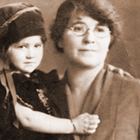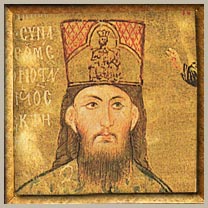Rob Moshein has written an excellent article on the challenges of finding Jewish ancestors and creating your own family tree.






From the Mayor of St. Petersburg
History of the Alexander Palace


Chronology
1792 - 1796
Design and construction of the Alexander Palace by Giacomo Quarenghi
1801 - 1825
Alexander I occupies the Palace as a permanent residence
1809
Interiors completed to the design of Luigi Rusca; Wall paintings completed by Giovanni Battista ScottI Private apartments of Nicholas I and Alexandra Fyodorovna redecorated; work attributed to Ivan Starov
1837
Crimson Drawing Room redecorated by Konstantin Ton
1825 - 1855
Nicholas I occupies the palace as a summer residence
1846
Iron balconies added to the garden elevation, designed by Alexander Briu1lov and Ippolit Monighetti
1855 - 1881
Alexander II occupies the palace as a permanent residence
1881 - 1894
Alexander III occupies the palace as a summer residence
1892
Exterior semi-circular steps to both the Imperial Suite and the English Suite re-built. Marble paving within the aula is removed and replaced with plants; marble slabs are re-used as interior paving
1894 - 1917
Nicholas II occupies the palace as a permanent residence
1895
Southeast wing of the palace reconfigured and redecorated by Roman Meltser to serve as private apartments of Nicholas II and Alexandra Fyodorovna. Northwest wing redecorated using furnishings supplied by the English design firm Maples & Co. to the design of Shrenburg
1898
Iron beams inserted into floors and ceilings of the Imperial wing; Field Church incorporated into the Crimson Room
1899
Artificial marble finishes restored; elevator installed in the Imperial Wing corridor Interior redecoration completed in the New Study, Maple Room and children's rooms
1903
Basement excavated under the aula; cast stone roof balustrade replaced with wood Roors above the children's rooms are repaired.
1917
Tsar Nicholas II and his family exiled to Tobolsk, and later executed
1918
Palace opened to the public as a museum
1920s
Upper floors of the Palace used as a "club house" for the secret police (NKVD). Portions of the Palace are use as a children's home for the Young Communist League (Komsomol)
1935
March 20: All-Russia Central Executive Committee designates the palace a historic landmark
1941 - 1944
German military forces blockade the city of Leningrad and occupy Tsarskoe Selo, including the Alexander Palace
1941 - 1945
The Palace is badly damaged by shelling. In addition to facade damage, the Mauve Sitting Room and comer rooms are virtually destroyed
1945
Control of the Alexander Palace is transferred to the USSR Academy of Sciences and the Institute of Russian Literature for proposed museum use. A comprehensive repair campaign is recommended, including repairs to the colonnade, restoration of the west wing to the Stasov design, and the return of Nicholas II and Alexandra Fyodorovna's apartments to Meltser's Art Nouveau design. Initial stages of the project are carried out by the state construction agency Lenakademstroiproyekt under the direction of architect L. M. Bezverkhnii
1951
Control of the Alexander Palace is reassigned to the Soviet Navy for use as a research institute Roof repairs are carried out, and heating system is repaired and upgraded; minor renovation is carried out to adapt the building for military use
1957
Annual maintenance and minor repairs carried out
1996
Alexander Palace registered on first World Monuments Watch List of 100 Most Endangered Sites. American Express Company awards a grant of $100,000 through the program to be directed toward emergency roof repair on the palace.
Design and construction of the Alexander Palace by Giacomo Quarenghi
1801 - 1825
Alexander I occupies the Palace as a permanent residence
1809
Interiors completed to the design of Luigi Rusca; Wall paintings completed by Giovanni Battista ScottI Private apartments of Nicholas I and Alexandra Fyodorovna redecorated; work attributed to Ivan Starov
1837
Crimson Drawing Room redecorated by Konstantin Ton
1825 - 1855
Nicholas I occupies the palace as a summer residence
1846
Iron balconies added to the garden elevation, designed by Alexander Briu1lov and Ippolit Monighetti
1855 - 1881
Alexander II occupies the palace as a permanent residence
1881 - 1894
Alexander III occupies the palace as a summer residence
1892
Exterior semi-circular steps to both the Imperial Suite and the English Suite re-built. Marble paving within the aula is removed and replaced with plants; marble slabs are re-used as interior paving
1894 - 1917
Nicholas II occupies the palace as a permanent residence
1895
Southeast wing of the palace reconfigured and redecorated by Roman Meltser to serve as private apartments of Nicholas II and Alexandra Fyodorovna. Northwest wing redecorated using furnishings supplied by the English design firm Maples & Co. to the design of Shrenburg
1898
Iron beams inserted into floors and ceilings of the Imperial wing; Field Church incorporated into the Crimson Room
1899
Artificial marble finishes restored; elevator installed in the Imperial Wing corridor Interior redecoration completed in the New Study, Maple Room and children's rooms
1903
Basement excavated under the aula; cast stone roof balustrade replaced with wood Roors above the children's rooms are repaired.
1917
Tsar Nicholas II and his family exiled to Tobolsk, and later executed
1918
Palace opened to the public as a museum
1920s
Upper floors of the Palace used as a "club house" for the secret police (NKVD). Portions of the Palace are use as a children's home for the Young Communist League (Komsomol)
1935
March 20: All-Russia Central Executive Committee designates the palace a historic landmark
1941 - 1944
German military forces blockade the city of Leningrad and occupy Tsarskoe Selo, including the Alexander Palace
1941 - 1945
The Palace is badly damaged by shelling. In addition to facade damage, the Mauve Sitting Room and comer rooms are virtually destroyed
1945
Control of the Alexander Palace is transferred to the USSR Academy of Sciences and the Institute of Russian Literature for proposed museum use. A comprehensive repair campaign is recommended, including repairs to the colonnade, restoration of the west wing to the Stasov design, and the return of Nicholas II and Alexandra Fyodorovna's apartments to Meltser's Art Nouveau design. Initial stages of the project are carried out by the state construction agency Lenakademstroiproyekt under the direction of architect L. M. Bezverkhnii
1951
Control of the Alexander Palace is reassigned to the Soviet Navy for use as a research institute Roof repairs are carried out, and heating system is repaired and upgraded; minor renovation is carried out to adapt the building for military use
1957
Annual maintenance and minor repairs carried out
1996
Alexander Palace registered on first World Monuments Watch List of 100 Most Endangered Sites. American Express Company awards a grant of $100,000 through the program to be directed toward emergency roof repair on the palace.





